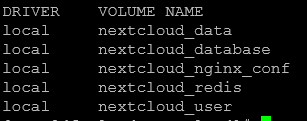NEXTCLOUD
Instalación de nextcloud mediante docker
INICIO
Instalación
La instalación consta de 4 servicios:
- db: Base de datos mariadb
- redes: Base de datos de memoria caché redis
- app: Aplicativo nextcloud
- web: Servidor web nginx
El primer paso es generar nuestro docker-compose:
db:
image: mariadb:10.11
container_name: nextcloud-db
restart: unless-stopped
command: --transaction-isolation=READ-COMMITTED --binlog-format=ROW
volumes:
- database:/var/lib/mysql
environment:
MYSQL_ROOT_PASSWORD: Ko5b0sq977j1saaCQ3SD55
MYSQL_DATABASE: nextcloud
MYSQL_USER: nextcloud
MYSQL_PASSWORD: Ko5b0sq977j1saaCQ3SD55
redis:
image: redis:alpine
container_name: nextcloud-redis
restart: unless-stopped
volumes:
- redis:/data
app:
image: nextcloud:fpm
container_name: nextcloud-app
restart: unless-stopped
ports:
- 9000:9000
depends_on:
- db
- redis
volumes:
- data:/var/www/html
- user:/var/nextcloud/data
- /datos/dFa:/mnt
environment:
MYSQL_HOST: db
MYSQL_DATABASE: nextcloud
MYSQL_USER: nextcloud
MYSQL_PASSWORD: Ko5b0sq977j1saaCQ3SD55
REDIS_HOST: redis
PHP_UPLOAD_LIMIT: 0
web:
image: nginx
container_name: nextcloud-web
restart: always
ports:
- 8080:80
depends_on:
- app
volumes:
- nginx_conf:/etc/nginx
- data:/var/www/html
volumes_from:
- app
volumes:
data:
driver: local
database:
driver: local
redis:
driver: local
nginx_conf:
driver: local
user:
driver: local
Los volúmenes se han configurado por las siguientes razones:
- database: Ficheros de la base de datos mysql
- redis: Ficheros de la base de datos redes
- data: Ficheros del aplicativo nextcloud (es necesario que lo usen tanto el contenedor app como el contenedor web)
- user: Ficheros de los perfiles de usuarios creados para nextcloud
- nginx_conf: Fichero nginx.conf
Además, en este caso, se ha realizado un bind de nuestro disco /datos para que sea utilizado como punto de montaje en nextcloud. Dado que es un contenedor, es necesario mapearlo para que la interfaz web tenga acceso al recurso de alguna manera.
Desplegamos los contenedores:

Y vemos que se han creado los volumenes correctamente:

Configuración
Con los volumenes creados, todavía nextcloud no es accesible, dado que debemos configurar tanto el config.php como como el nginx.conf.
nginx.conf
El fichero nginx.conf se encuentra en el volumen nextcloud_nginx_conf. Realizamos previamente un backup y reemplazamos por el siguiente:
error_log /var/log/nginx/error.log warn;
pid /var/run/nginx.pid;
events {
worker_connections 1024;
}
http {
include mime.types;
default_type application/octet-stream;
types {
text/javascript mjs;
application/wasm wasm;
}
log_format main '$remote_addr - $remote_user [$time_local] "$request" '
'$status $body_bytes_sent "$http_referer" '
'"$http_user_agent" "$http_x_forwarded_for"';
access_log /var/log/nginx/access.log main;
sendfile on;
keepalive_timeout 65;
# Define asset_immutable variable properly
map $arg_v $asset_immutable {
default "";
"" ", immutable";
}
upstream php-handler {
server app:9000;
}
server {
listen 80;
client_max_body_size 512M;
client_body_timeout 300s;
fastcgi_buffers 64 4K;
client_body_buffer_size 512k;
gzip on;
gzip_vary on;
gzip_comp_level 4;
gzip_min_length 256;
gzip_proxied expired no-cache no-store private no_last_modified no_etag auth;
gzip_types application/atom+xml text/javascript application/javascript application/json application/ld+json application/manifest+json application/rss+xml application/vnd.geo+json application/vnd.ms-fontobject application/wasm application/x-font-ttf application/x-web-app-manifest+json application/xhtml+xml application/xml font/opentype image/bmp image/svg+xml image/x-icon text/cache-manifest text/css text/plain text/vcard text/vnd.rim.location.xloc text/vtt text/x-component text/x-cross-domain-policy;
add_header Referrer-Policy "no-referrer" always;
add_header X-Content-Type-Options "nosniff" always;
add_header X-Frame-Options "SAMEORIGIN" always;
add_header X-Permitted-Cross-Domain-Policies "none" always;
add_header X-Robots-Tag "noindex, nofollow" always;
add_header X-XSS-Protection "1; mode=block" always;
fastcgi_hide_header X-Powered-By;
root /var/www/html;
index index.php index.html /index.php$request_uri;
location = / {
if ( $http_user_agent ~ ^DavClnt ) {
return 302 /remote.php/webdav/$is_args$args;
}
}
location = /robots.txt {
allow all;
log_not_found off;
access_log off;
}
location ^~ /.well-known {
location = /.well-known/carddav { return 301 /remote.php/dav/; }
location = /.well-known/caldav { return 301 /remote.php/dav/; }
location /.well-known/acme-challenge { try_files $uri $uri/ =404; }
location /.well-known/pki-validation { try_files $uri $uri/ =404; }
return 301 /index.php$request_uri;
}
location ~ ^/(?:build|tests|config|lib|3rdparty|templates|data)(?:$|/) { return 404; }
location ~ ^/(?:\.|autotest|occ|issue|indie|db_|console) { return 404; }
location ~ \.php(?:$|/) {
rewrite ^/(?!index|remote|public|cron|core\/ajax\/update|status|ocs\/v[12]|updater\/.+|ocs-provider\/.+|.+\/richdocumentscode(_arm64)?\/proxy) /index.php$request_uri;
fastcgi_split_path_info ^(.+?\.php)(/.*)$;
set $path_info $fastcgi_path_info;
try_files $fastcgi_script_name =404;
include fastcgi_params;
fastcgi_param SCRIPT_FILENAME $document_root$fastcgi_script_name;
fastcgi_param PATH_INFO $path_info;
fastcgi_param HTTPS on;
fastcgi_param modHeadersAvailable true;
fastcgi_param front_controller_active true;
fastcgi_pass php-handler;
fastcgi_intercept_errors on;
fastcgi_request_buffering off;
fastcgi_max_temp_file_size 0;
}
location ~ \.(?:css|js|mjs|svg|gif|ico|jpg|png|webp|wasm|tflite|map|ogg|flac)$ {
try_files $uri /index.php$request_uri;
add_header Cache-Control "public, max-age=15778463$asset_immutable";
access_log off;
}
location ~ \.wasm$ {
default_type application/wasm;
}
location /remote {
return 301 /remote.php$request_uri;
}
location / {
try_files $uri $uri/ /index.php$request_uri;
}
}
}
config.php
Hacemos lo mismo con el fichero config.php que se encuentra en el volumen app dentro del directorio config:
$CONFIG = array (
'memcache.local' => '\\OC\\Memcache\\APCu',
'apps_paths' =>
array (
0 =>
array (
'path' => '/var/www/html/apps',
'url' => '/apps',
'writable' => true,
),
1 =>
array (
'path' => '/var/www/html/custom_apps',
'url' => '/custom_apps',
'writable' => true,
),
),
'memcache.distributed' => '\\OC\\Memcache\\Redis',
'memcache.locking' => '\\OC\\Memcache\\Redis',
'redis' =>
array (
'host' => 'redis',
'password' => '',
'port' => 6379,
),
'upgrade.disable-web' => true,
'instanceid' => 'ocxuwrcpcats',
'passwordsalt' => 'bFuPjx3NMpliQCtY729Uob2SRp19xe',
'secret' => 'eFMG77LAdbjw6oPSJM7hL/IDPBnP3qDxE7xlX6/uPMOvQ/kG',
'trusted_domains' =>
array (
0 => '10.100.200.35:8080',
1 => 'dfacloud.ddns.net',
),
'datadirectory' => '/var/nextcloud/data',
'dbtype' => 'mysql',
'version' => '30.0.6.2',
'overwrite.cli.url' => 'https://dfacloud.ddns.net',
'dbname' => 'nextcloud',
'dbhost' => 'db',
'dbport' => '',
'dbtableprefix' => 'oc_',
'mysql.utf8mb4' => true,
'dbuser' => 'nextcloud',
'dbpassword' => 'Ko5b0sq977j1saaCQ3SD55',
'installed' => true,
);
En este fichero php tendremos que tener en cuenta modificar los valores nuestra dirección ip:puerto y nuestra dns en consecuencia.